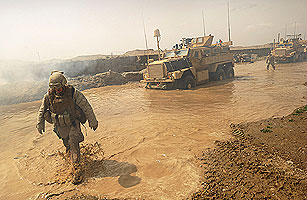
The towers had fallen, taking thousands of civilian lives, but the man named architect of the attacks was still walking free. After 9/11, President George W. Bush demanded that the Taliban, which had seized control of Afghanistan in 1996, give Osama bin Laden up. When the extremist Islamic regime refused, American forces invaded the country that continues to be the site of the U.S.'s foremost military struggle. By the end of the year they had driven the Taliban from power and displaced the network it was harboring, al-Qaeda. Their crusade, however, did not eliminate either group.
From the mountains where it had taken refuge, and as the U.S. military turned its attentions to Iraq, the Taliban regrouped. Its resurgence was largely fueled by a lucrative opium trade and growing dissatisfaction with the new Afghan government led by Hamid Karzai. The stubborn insurgency began gaining ground — specifically, large stretches of countryside. President Barack Obama has stepped up "Operation Enduring Freedom," as the war in Afghanistan has been christened, increasing the number of troops there by almost 50,000. But despite recent tactical advances and a plan to hand off to Afghan forces by 2014, the Taliban still holds strong and the country's leadership remains corrupt and weak.